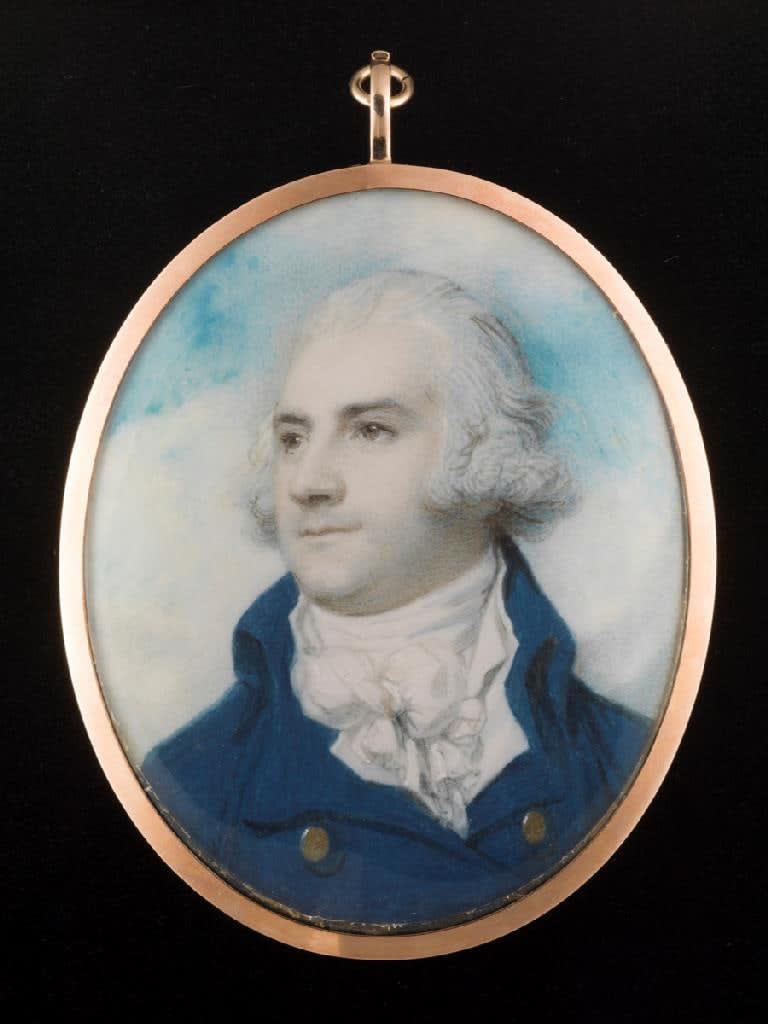
Richard Cosway
Portrait miniature of a Gentleman, wearing blue coat with gold buttons, tied stock and frilled cravat, c. 1790
Watercolour on ivory
Oval, 76 mm (3 ins) high
Philip Mould & Co.
To view all current artworks for sale visit philipmould.com Cosway was one of the leading portrait miniature painters of the eighteenth century, who, along with a handful of competitors, fed...
To view all current artworks for sale visit philipmould.com
Cosway was one of the leading portrait miniature painters of the eighteenth century, who, along with a handful of competitors, fed the hunger for the virtuoso grandeur which so typified the Regency period.
Born in Devon, the son of a headmaster was attracted to art from an early age and by the age of twelve was working in London under Thomas Hudson and learning at Shipley’s drawing school. Cosway first exhibited at the Society of Artists in 1760 and entered the Royal Academy Schools in 1769, exhibiting there 1770-1806. Cosway was made Miniature Painter to the Prince of Wales in around 1786, a position he maintained until the Prince became Regent in 1811.
Perhaps the most characteristic feature of Cosway’s work is the captivating level of luminosity he manages to create. Throughout his career Cosway mastered the use of transparent pigments, which when applied diligently onto ivory exploited the natural glow of the support, as seen in the present work. Another distinguishable feature of Cosway’s work is the sky background, which was exemplified by Cosway and later adopted by competitors such as Andrew Plimer (1763-1837), who, along with brother Nathaniel, Cosway taught to paint.
The present work dates to circa 1790 and was painted at a time when Cosway very much dominated the market for portrait miniatures. Cosway’s oeuvre during this period can be found filled with portraits of various English and French aristocrats perhaps one of the best examples being his portrait of the Prince of Wales circa 1793 [Royal Collection].
The present work would also have been one of the first generation of works Cosway produced on these larger pieces of ivory, preferring in his earlier years to work on a smaller scale and use much plainer backgrounds. The period 1785-1806 is regarded by Foskett as his best period of work and despite the fact the sitter is as of yet unidentified, he must have been an affluent gentleman to have afforded a sitting at this point of the artist’s career.
The miniature was previously owned by J. B. Robertson, a descendent of Andrew Robertson, who owned several miniatures by him. Family tradition asserted that this was a self-portrait of Richard Cosway, although comparison with his physiognomy as an older man now makes this identification untenable.
Cosway was one of the leading portrait miniature painters of the eighteenth century, who, along with a handful of competitors, fed the hunger for the virtuoso grandeur which so typified the Regency period.
Born in Devon, the son of a headmaster was attracted to art from an early age and by the age of twelve was working in London under Thomas Hudson and learning at Shipley’s drawing school. Cosway first exhibited at the Society of Artists in 1760 and entered the Royal Academy Schools in 1769, exhibiting there 1770-1806. Cosway was made Miniature Painter to the Prince of Wales in around 1786, a position he maintained until the Prince became Regent in 1811.
Perhaps the most characteristic feature of Cosway’s work is the captivating level of luminosity he manages to create. Throughout his career Cosway mastered the use of transparent pigments, which when applied diligently onto ivory exploited the natural glow of the support, as seen in the present work. Another distinguishable feature of Cosway’s work is the sky background, which was exemplified by Cosway and later adopted by competitors such as Andrew Plimer (1763-1837), who, along with brother Nathaniel, Cosway taught to paint.
The present work dates to circa 1790 and was painted at a time when Cosway very much dominated the market for portrait miniatures. Cosway’s oeuvre during this period can be found filled with portraits of various English and French aristocrats perhaps one of the best examples being his portrait of the Prince of Wales circa 1793 [Royal Collection].
The present work would also have been one of the first generation of works Cosway produced on these larger pieces of ivory, preferring in his earlier years to work on a smaller scale and use much plainer backgrounds. The period 1785-1806 is regarded by Foskett as his best period of work and despite the fact the sitter is as of yet unidentified, he must have been an affluent gentleman to have afforded a sitting at this point of the artist’s career.
The miniature was previously owned by J. B. Robertson, a descendent of Andrew Robertson, who owned several miniatures by him. Family tradition asserted that this was a self-portrait of Richard Cosway, although comparison with his physiognomy as an older man now makes this identification untenable.
Provenance
Possibly the artist Andrew Robertson, thence by family descent toJ.B. Robertson, Esq., Dalchonzie House, Comrie, Perthshire from whose collection sold at Christie’s, 12th July 1988, lot 192;
Christies, 14th October 1998, lot 210;
Private collection